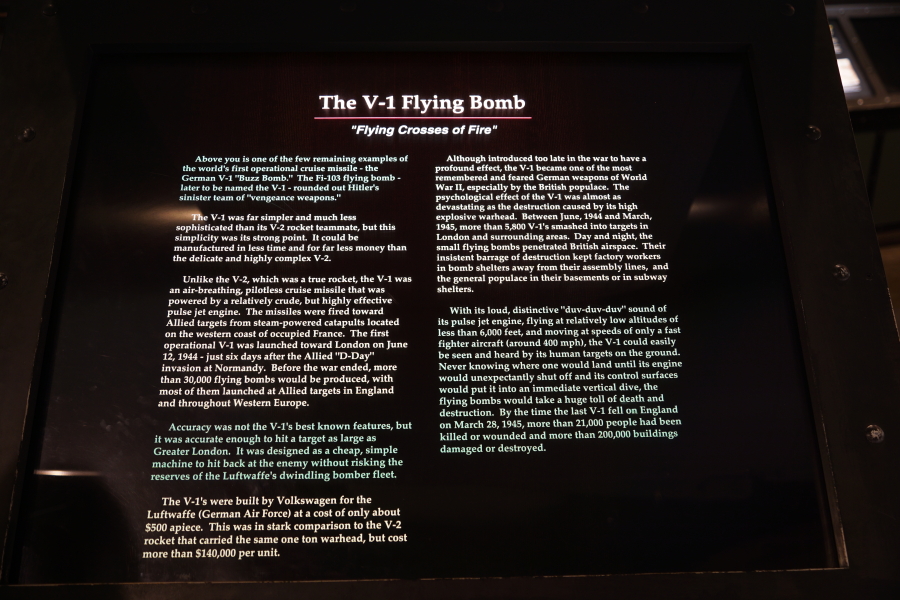| Prev |
heroicrelics.org Kansas Cosmosphere Site Index V-1 Gallery |
Next |
dscc5355.jpg
One of the signs accompanying the buzz bomb. It reads
The V-1 Flying Bomb
"Flying Crosses of Fire"
Above you is one of the few remaining examples of the world's first operational cruise missile - the German V-1 "Buzz Bomb." The Fi-103 flying bomb - later to be named the V-1 - rounded out Hitler's sinister team of "vengeance weapons."
The V-1 was far simpler and much less sophisticated than its V-2 rocket teammate, but this simplicity was its strong point. It could be manufactured in less time and for far less money than the delicate and highly complex V-2.
Unlike the V-2, which was a true rocket, the V-1 was an air-breathing, pilotless cruise missile that was powered by a relatively crude, but highly effective pulse jet engine. The missiles were fired toward Allied targets from steam-powered catapults located on the western coast of occupied France. The first operational V-1 was launched toward London on June 12, 1944 - just six days after the Allied "D-Day" invasion at Normandy. Before the war ended, more than 30,000 flying bombs would be produced, with most of them launched at Allied targets in England and throughout Western Europe.
Accuracy was not the V-1's best-known feature, but it was accurate enough to hit a target as large as Greater London. It was designed as a cheap, simple machine to hit back at the enemy without risking the reserves of the Luftwaffe's dwindling bomber fleet.
The V-1s were built by Volkwagen for the Luftwaffe (German Air Force) at a cost of only about $500 apiece. This was in stark comparison to the V-2 rocket that carried the same one ton warhead, but cost more than $140,000 per unit.
Although introduced too late in the war to have a profound effect, the V-1 became one of the most remembered and feared German weapons of World War II, especially by the British populace. The psychological effect of the V-1 was almost as devastating as the destruction caused by its high explosive warhead. Between June, 1944 and March, 1945, more than 5,800 V-1s smashed into targets in London and surrounding areas. Day and night, the small flying bombs penetrated British airspace. Their insistent barrage of destruction kept factory workers in bomb shelters away from their assembly lines, and the general populace in their basements or in subway shelters.
With the loud, distinctive "duv-duv-duv" sound of its pulse jet engine, flying at relatively low altitudes of less than 6,000 feet, and moving at speeds of only a fast fighter aircraft (around 400 mph), the V-1 could easily be seen and heard by its human targets on the ground. Never knowing where one would land until its engine would unexpectedly shut off and its control surfaces would put it into an immediate vertical dive, the flying bombs would take a huge toll of death and destruction. By the time the last V-1 fell on England on March 28, 1945, more than 21,000 people had been killed or wounded and more than 200,000 buildings damaged or destroyed.

| Time picture taken | Thu Apr 14 11:11:44 2016 |
| Location picture taken |
German Gallery Space Hall Kansas Cosmosphere Hutchinson, KS |
| Prev |
heroicrelics.org Kansas Cosmosphere Site Index V-1 Gallery |
Next |